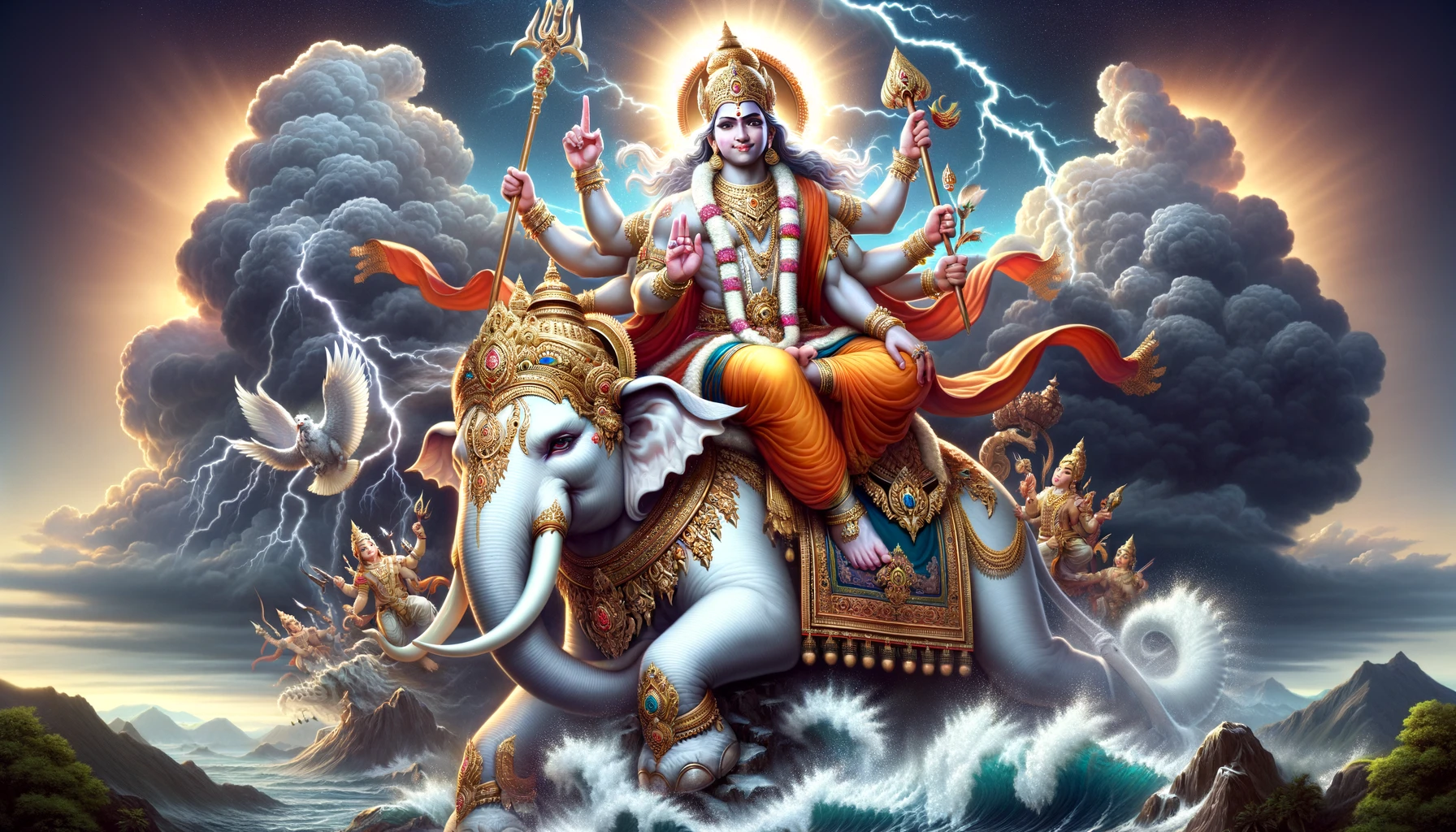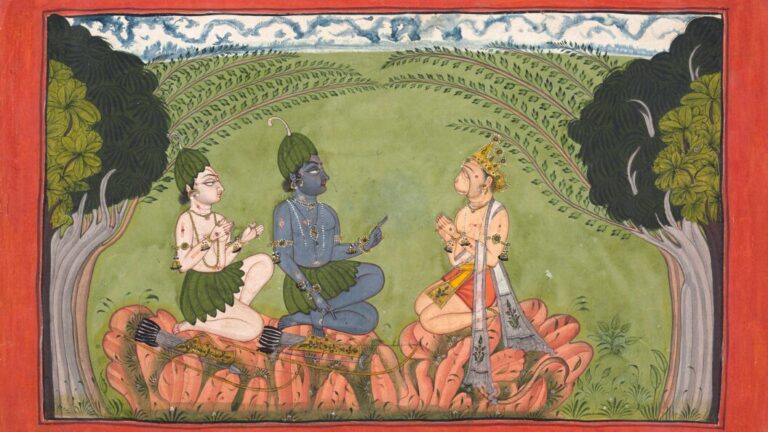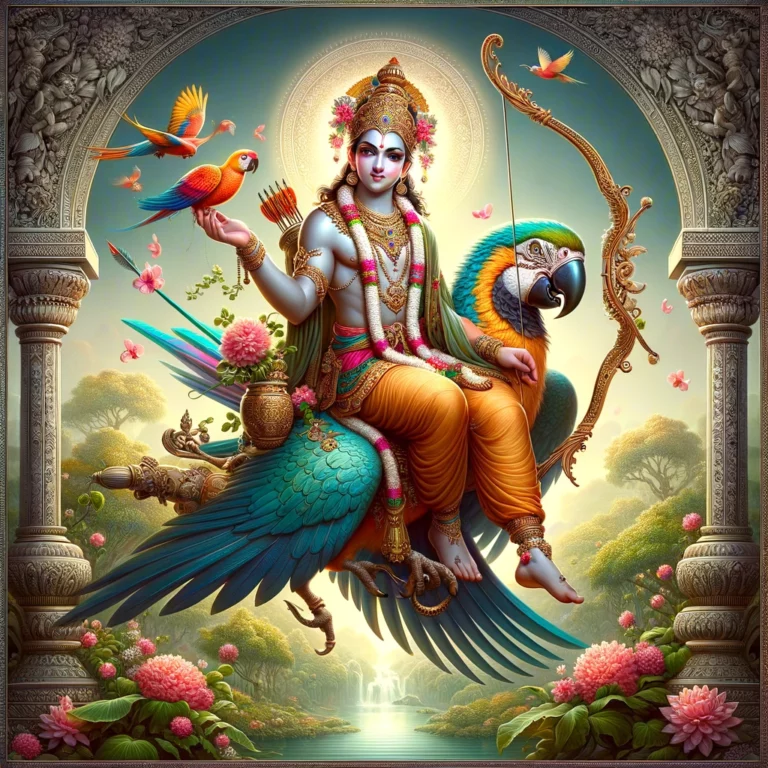Ever wondered who controls the rain in the vast expanse of Hindu mythology? Let’s dive straight into the heart of this rainy mystery: meet lord Indra, the Hindu God of Rain, a deity with the formidable power to summon storms and showers with a flick of his wrist.
As the king of the gods, Indra plays a pivotal role in the celestial hierarchy, holding the reins over the weather and wielding his thunderbolt with unmatched prowess.
Lord Indra – Hindu God Of Rain
Imagine if your job description included controlling the weather, battling demons, and being the ultimate protector of the cosmos.
Sounds intense, right?

That’s all in a day’s work for Lord Indra.
With his mighty thunderbolt, Vajra, and his magnificent steed, the white elephant Airavata, Indra ensures the forces of good always triumph over evil.
Fun Fact: Indra’s thunderbolt, Vajra, isn’t just for show. It symbolizes his immense power and is believed to be the most potent weapon in the universe. So, when it comes to superhero gadgets, Indra’s got everyone beat!
Indra’s significance goes beyond just being the Hindu God of Rain. He embodies the virtues of bravery, strength, and the protective nature of a ruler.
His stories are filled with epic battles, great victories, and the relentless pursuit of justice and harmony.
But why should we care about an ancient deity in today’s world?
Well, Indra’s tales teach us about the importance of balance in nature, the responsibility we have towards our environment, and the power of righteousness.
In a way, understanding Indra’s role helps us appreciate the intricate connections between the divine, the natural world, and humanity.
So, buckle up!
We’re about to embark on a journey through ancient texts, uncovering the legends of Indra, exploring his iconic symbols, and diving deep into the mythology that paints him as the ultimate divine weatherman.
Spoiler alert: It’s a story filled with thunderous battles, celestial drama, and a bit of divine intervention!
Lord Indra’s Iconography and Symbols
When you envision Lord Indra, what comes to mind?
Maybe it’s a mighty warrior poised for battle, or perhaps it’s a divine being with an aura of calm authority.
In Hindu art and scriptures, Lord Indra is depicted with several iconic symbols, each telling a part of his story and the powers he wields.
- The Vajra: At the top of the list is the Vajra, Lord Indra’s thunderbolt. It’s not just any weapon; it’s the ultimate symbol of strength and resilience. Crafted from the bones of the sage Dadhichi, the Vajra can demolish any obstacle in its path. Think of it as the ancient version of a superhero’s shield, but way cooler because it can control thunder and lightning!
- The Elephant Airavata: Then there’s Airavata, the white elephant that serves as Lord Indra’s mount. Airavata is no ordinary elephant; this magnificent creature can summon rain, making it an essential ally in Lord Indra’s role as the God of Rain. Together, they’re a dynamic duo, bringing life-giving waters to the Earth.
So, why are these symbols important?
Well, they’re not just accessories. They represent Lord Indra’s power over the natural elements and his responsibility as a protector. The Vajra and Airavata are symbols of might, benevolence, and the cycle of life that Lord Indra oversees.
Let’s take a moment to appreciate this: Lord Indra, with his thunderbolt in hand and riding atop Airavata, isn’t just an image of divine authority. He’s a reminder of the balance between power and grace, destruction and creation, and the continual nurturing of life on Earth.
In a way, the iconography of Lord Indra teaches us about the importance of harmony with nature and the strength found in righteousness and duty.
And honestly, who wouldn’t want a thunderbolt that controls the weather and an elephant that calls forth rain?
Sounds like the ultimate eco-friendly combo!
Lord Indra’s Mythological Tales and Exploits
Diving into the epic sagas of Hindu mythology, we find Lord Indra at the heart of many thrilling adventures. These stories aren’t just ancient myths; they’re tales of heroism, cosmic battles, and the eternal fight between good and evil.
Let’s zoom in on a few of Lord Indra’s most legendary exploits:
The Battle with Vritra
Picture this: the world is in dire drought, suffering under the tyranny of the demon Vritra, who has hoarded all the waters.
Enter Lord Indra, our hero, who takes up his Vajra, faces the formidable foe, and after a fierce battle, slays Vritra, releasing the pent-up waters and bringing life back to Earth.
This isn’t just an action-packed story; it’s a symbolic reminder of the triumph of light over darkness.
The Churning of the Ocean (Samudra Manthan)
In this cosmic event, gods and demons come together to churn the ocean of milk, seeking the nectar of immortality, Amrita.
Lord Indra plays a crucial role in this celestial tug-of-war, showcasing his leadership and strategic prowess.
The churning brings forth not just Amrita but also various divine treasures, each with its guardian deity.
It’s like the ultimate treasure hunt, but with the fate of the universe at stake!
Indra and the Sacred Soma
In yet another tale, Lord Indra is famed for his quest for Soma, the divine nectar. This isn’t just about divine indulgence; Soma represents strength, health, and vitality.
Lord Indra’s quest for Soma underscores his role as a nurturer of life and a guardian of divine elixirs that sustain the gods and, by extension, the balance of the cosmos.
Why do these stories matter?
They’re not just entertaining yarns; they embody deep philosophical truths and moral lessons.
Lord Indra’s battles are metaphors for the human spirit’s resilience, the importance of courage, and the virtue of perseverance in the face of adversity.
Here’s a thought: Next time you’re caught in a rain shower, imagine Lord Indra, with his Vajra in hand, riding Airavata, battling the forces of drought to bring you the refreshing rains. It’s a nice way to connect with the timeless tales of Hindu mythology and find inspiration in the natural world around us.
And guess what?
These stories have inspired countless artworks, poems, and rituals, making Lord Indra a central figure in Hindu culture and spirituality.
His exploits remind us that even in the darkest times, hope and bravery can bring about a new dawn.
Worship and Reverence of Hindu God of Rain
Now, let’s get a bit personal with Lord Indra.
You might be thinking, “Sure, he’s powerful and all, but how do people show their respect and admiration for him?”
Great question!
The worship of Lord Indra, while not as prevalent in daily rituals as it once was, carries profound significance in Hindu culture, especially during specific festivals and in the Rigveda, where he’s a central figure.
Rigveda and Lord Indra
The Rigveda, one of the oldest texts known to humanity, is like a fan club newsletter for Lord Indra.
Okay, maybe not exactly, but it does praise him as a mighty warrior, the king of gods, and the bringer of rain.
With over 250 hymns dedicated to him, it’s clear Lord Indra was a big deal.
These hymns aren’t just old songs; they’re powerful affirmations of faith and respect towards the forces of nature and the divine.
Festivals Honoring Lord Indra
Think of these as the ancient equivalent of a ticker-tape parade for our rain-bringing hero.
In certain regions of India, festivals like Indra Jatra celebrate Lord Indra’s generosity in bringing rain to the land.
These festivals are vibrant, filled with music, dance, and, of course, prayers for rain and prosperity.
It’s a way for communities to come together, expressing gratitude and hoping for continued blessings from the skies.
Why is this important?
Well, it shows that even gods like Lord Indra appreciate a good thank-you note.
More seriously, it highlights the human connection to the divine, acknowledging the gods’ role in the natural world and our lives.
It’s a relationship built on respect, gratitude, and a touch of awe for the cosmic balance they maintain.
Fun Fact: Did you know that despite his awe-inspiring powers, Lord Indra also shows us the value of humility? Yes, even the king of gods has moments that remind him (and us) of the virtues of modesty and the importance of facing one’s flaws.
It’s comforting to know that everyone has room to grow, right?
So, the next time you enjoy the cool relief of a rain shower, remember Lord Indra and the ancient rituals and hymns that celebrate his life-giving powers.
It’s a beautiful way to connect with the past, acknowledging the timeless bond between humanity and the divine.
And hey, who doesn’t love a good rain dance?
Maybe it’s time to start your own tradition in honor of Lord Indra.
Just an idea…!
Lord Indra’s Festivals and Cultural Significance
Let’s talk festivals, because if there’s one thing that brings color and life to the stories of Lord Indra, it’s the vibrant celebrations in his honor.
Lord Indra, the Hindu God of Rain, isn’t just about thunderstorms and wielding a mighty thunderbolt; he’s also a figure of joy and gratitude in the agricultural communities that rely on his blessings for their crops.
Indra Jatra
This is where things get lively.
Indra Jatra is a festival celebrated with great pomp in parts of Nepal, marking the end of the monsoon season.
Picture this: streets filled with music, masks, and dances, all paying homage to Lord Indra for the rains that nourish the land. It’s not just fun and games; it’s a profound expression of gratitude to the deity who ensures the earth stays fertile and green.
Agricultural Festivals
Across India, various regions celebrate the arrival of the monsoon in ways that honor Lord Indra’s role as the bringer of rains.
These festivals might not all bear his name, but the spirit of thanking the divine for rainfall, essential for agriculture, is a common thread.
It’s like throwing a massive “thank you” party for the skies.
Why do these celebrations matter?
They’re a reminder of our deep connection with nature and the cycles that govern life on Earth.
In today’s fast-paced world, it’s easy to forget the simple yet profound joy of watching rain revive a parched land. These festivals invite us to pause, look up, and appreciate the natural wonders that sustain us.
Here’s a fun thought: Imagine if we celebrated every little blessing with the same enthusiasm as an Indra Jatra parade. The world would be a happier, more colorful place, don’t you think?
Cultural Impact
Beyond the festivities, Lord Indra’s influence extends into the arts, literature, and even the way societies understand the forces of nature.
His tales are woven into the fabric of Hindu culture, serving as metaphors for life’s struggles, triumphs, and the eternal quest for balance and harmony.
So, next time you hear the rumble of thunder, think of it as Lord Indra’s way of saying hello, reminding you of the ancient rhythms that dance through our lives.
And maybe, just maybe, you’ll feel a bit more connected to the world around you, finding joy in the simple miracle of rain.
In conclusion, Lord Indra’s festivals and the cultural significance attached to them highlight not just a deity’s role in the natural world but also the human capacity for reverence, celebration, and connection to the environment.
The Legacy of Lord Indra in Hindu Art and Temples
When we step into the world of Hindu art and architecture, Lord Indra’s presence is as commanding as the thunderstorms he’s associated with.
His legacy is not just in the myths and stories passed down through generations but also in the stone and paint that adorn India’s ancient temples and artworks.
Let’s delve into how Lord Indra’s, Hindu God of rain, divine persona is captured in the realm of art and worship.
- Temple Sculptures: In many Hindu temples, you’ll find intricate carvings of Lord Indra, often depicted riding Airavata, his mighty elephant. These sculptures aren’t just decorative; they’re a form of reverence, capturing the essence of Lord Indra’s power and his role as a protector of the Dharma. Each carving tells a story, a frozen moment of mythology brought to life in stone.
- Classical Indian Literature: Lord Indra’s exploits and virtues are celebrated in epics like the Mahabharata and the Ramayana, where his strength and wisdom often aid heroes in their quests. These stories, recited and read for centuries, have cemented Lord Indra’s status as a pivotal figure in Hindu mythology, inspiring countless works of literature and art.
Why is this artistic legacy important?
It’s a bridge between the past and present, a visual and narrative testament to the enduring relevance of Lord Indra in Hindu culture.
Through art and architecture, the tales of Lord Indra continue to inspire, teach, and provide spiritual guidance to millions.
Imagine this: As you walk through the corridors of an ancient temple, you’re not just seeing stone and paint; you’re walking through a gallery of stories, each sculpture inviting you to ponder the divine dramas that have shaped the world.
And it’s not all serious: Some depictions of Lord Indra show him in lighter moments, reminding us that the divine, too, can partake in joy and celebration. It’s a reminder that spirituality encompasses all facets of life, from the solemn to the joyful.
So, the next time you admire a piece of Hindu art or architecture, remember that you’re witnessing the legacy of Lord Indra, a deity whose influence transcends the boundaries of heaven and earth.
Hindu Lord Of Rain and Other Weather Gods
Ever noticed how every culture has a weather god?
Let’s compare Lord Indra with others. It’s like finding out who’s the best at controlling the weather.
- Zeus: Over in Greek mythology, Zeus throws lightning bolts. Sounds familiar? Both he and Lord Indra love their thunder weapons.
- Thor: Then there’s Thor from Norse myths. He has a hammer and controls thunder, just like Indra with his Vajra.
- Raijin: Japan’s Raijin bangs drums to create thunder. Different instrument, same weather vibe.
Why compare? It shows how humans everywhere think alike. We all imagine powerful beings controlling nature.
Fun fact: Did you know that despite these gods’ fierce powers, they often teach us about strength and protection? It’s not all about throwing lightning around.
So, next time it rains, think of it as a little hello from the weather gods.
Whether it’s Lord Indra, Hindu God of rain or another deity, they’re all about keeping life going.
Pretty cool, right?
Conclusion: Lord Indra, The Hindu God of Rain
So, what’s the big deal with Lord Indra today?
Even though he might seem like an ancient myth, his stories are still super relevant. Here’s why:
- Nature’s Balance: Lord Indra reminds us of the power and beauty of nature. He’s all about rain and storms, showing how important they are for life.
- Heroic Values: His tales teach us about bravery and doing the right thing, even when it’s tough.
Think about it: In a world facing climate change, respecting nature like Lord Indra did is more important than ever.
Also, a bit of fun: Imagine having the power to control the weather. What would you do? Lord Indra had that job way before it was cool.
In short, Lord Indra’s not just an old story. He’s a reminder of our connection to the environment and the values we should live by.
Pretty relevant, don’t you think?
Frequently Asked Questions – Hindu God of Rain
Who is Lord Indra in Hindu mythology?
Lord Indra is the Hindu god of rain, thunderstorms, and war. He is known as the king of the gods (Devas) and resides in Svarga (heaven). Indra wields a thunderbolt and rides a white elephant named Airavata.
What are the symbols associated with Lord Indra?
The main symbols associated with Lord Indra are the Vajra (thunderbolt) and Airavata, his white elephant. The Vajra represents strength and the lightning power, while Airavata symbolizes water and fertility.
What are some famous stories involving Lord Indra?
Famous stories involving Lord Indra include his battle with the demon Vritra to release the waters, his participation in the churning of the ocean (Samudra Manthan) to obtain Amrita (the nectar of immortality), and his quest for the sacred Soma.
How is Lord Indra worshipped?
While direct worship of Lord Indra is less common in contemporary Hindu practice, he is revered in festivals like Indra Jatra and through hymns in the Rigveda. He is celebrated for his role in bringing rain and maintaining the balance of the natural world.
How does Lord Indra compare to weather gods in other mythologies?
Lord Indra shares similarities with weather gods from other mythologies, such as Zeus in Greek mythology and Thor in Norse mythology, particularly in their control over thunder and lightning. These parallels highlight the universal theme of gods governing the natural elements.


